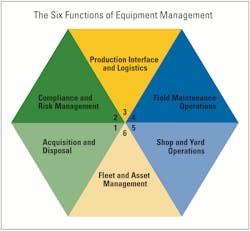Equipment management is a complex and difficult task that affects almost every aspect of a company’s operations. The skills required vary from the master mechanic to the finance specialist, and organization structures depend more on the personalities involved than careful planning and forethought. There is no doubt that every company is different and every equipment fleet is managed differently. There is no “one size fits all” company and there is no “right way” to manage a fleet.
There are, however, six functions that must be competently performed in order to get the job done. They are presented as segments in the graphic at right. Let’s describe the functions and use the diagram to make sure that an organization covers all the bases and that everyone understands their responsibilities and contribution to the business. As you go through each function, think about how important it is, who is responsible and how you measure success.
The Construction Equipment Executive Institute offers more asset management, including a webinar on The Hexagon.
We will start at the bottom left and go clockwise around the hexagon.
Acquisition and disposal
Effective acquisition and disposal is not just a question of buying low and selling high. Acquisition makes up a major portion of total owning cost and requires that we make wise long-term technical and commercial decisions based on our knowledge of the market and the relationships we have established with manufacturers and finance organizations. We need to develop specifications tailored to our needs, have policies on standardization and know how to structure purchase, lease, rental-purchase or rental agreements suited to our financial and tax situation.
Disposing of equipment at the best possible price is also not a simple task. It requires that we understand the used equipment market, explore every possible alternative and maintain effective relationships with dealers and agents.
Compliance and risk management
This function makes up the second portion of total owning cost and covers the steps needed to ensure that our assets comply with all regulations and are licensed, insured and inspected as needed. On the surface it appears to be a relatively simple routine task. It is, however, growing in cost and complexity on a daily basis as we see more and more emphasis on complex insurance requirements, emissions standards and safety regulations. This function becomes extremely complex when operations are performed in many states or in international markets. It simply cannot be neglected.
Transport and logistics
Acquisition and disposal ensure that we have the required equipment in our fleet; compliance and risk management ensure that it is legal. The transport and logistics function moves it to the right place at the right time. Effective dispatch and tracking operations are essential for fleet utilization and many companies run large transportation fleets that move equipment on a daily basis. Questions often arise as to whether the costs involved should be part of the equipment rate or be charged directly to the projects involved. Regardless, it is another cost that must be controlled and another equipment management function that must be competently performed.
Field maintenance operations
This function covers all the actions needed to make sure that the equipment on site is up and running and able to work on a daily basis. It includes fueling and daily inspections, periodic and preventive maintenance and the replacement of wear parts. The costs involved form part of total operating cost and must be included in the equipment rate. Questions arise when it comes to deciding who sets field maintenance standards, who is responsible for differences between actual and budgeted costs and who is responsible for field maintenance mechanics. Clearly, small projects cannot assume these responsibilities, clearly large projects can and, perhaps, should.
Shop and yard operations
Changes in machine design, shortages of field personnel and the need to work under controlled conditions means that very little repair, renovation or rebuild work is done in the field. Shop and yard operations, either self performed or outsourced, lie at the heart of a process whereby machines come off field assignment, are repaired, renovated or rebuilt and made ready for their next job.
The costs involved make up the second component of total operating cost and the success of this function determines the long-term capability and reliability of the equipment fleet. It is critical for the success of the company and many aspects can benefit from the efficiency and specialization achieved through outsourcing.
Fleet and asset management
The fleet and asset management function is responsible for strategic decisions regarding fleet composition, fleet average age, capital expenditure, finance, tax and return on investment. It absorbs data from the other functions, interfaces with the company strategic planning process and develops the rates, estimates, budgets, benchmarks and standards needed to manage the whole process.
A focus on this function can achieve substantial benefits in terms of capital structure, tax planning, cash management and return on investment. Successful companies excel in this area and make strategic decisions that balance the technical, operational and financial aspects of managing the fleet as a major corporate asset.
Let’s use the six functions and their arrangement in the hexagon to draw some general conclusions regarding the way we organize our company to better manage the fleet.
First. The three functions in the top half of the hexagon—compliance and risk management, transport and logistics and field maintenance operations—are short-term immediate issues of primary concern to the site. They want equipment that is legal, in the right place and working. Project teams can, and in many situations should, manage these functions within a framework of clear and strongly enforced policies.
Second. The three functions in the bottom half of the hexagon—acquisition and disposal, shop and yard operations and fleet and asset management—are long-term strategic issues of primary concern to the company and its long-term future. There is no doubt that the lower three functions are the province of the equipment professional and that they should be managed for the long run. Competence in these functions is a corporate responsibility and a prerequisite for success in the upper three functions.
Third. Functions 1 and 2 make up the owning costs, functions 4 and 5 make up the operating cost. Interestingly each has a long term “invest for the future” component (1 and 5) and each has a monthly or hourly cost component (2 and 4). Function 6 makes sure that the fleet age, size and composition match corporate requirements, function 3 makes sure the fleet is deployed in the right place at the right time.
Fourth. It should be possible to review each of the functions and assess its importance to your company. It should also be possible to identify the individuals or teams who have primary responsibility for each function and see whether they have the knowledge, guidance and authority needed to succeed.
About the Author

Mike Vorster
Mike Vorster is the David H. Burrows Professor Emeritus of Construction Engineering at Virginia Tech and is the author of “Construction Equipment Economics,” a handbook on the management of construction equipment fleets. Mike serves as a consultant in the area of fleet management and organizational development, and his column has been recognized for editorial excellence by the American Society of Business Publication Editors.
Read Mike’s asset management articles.
